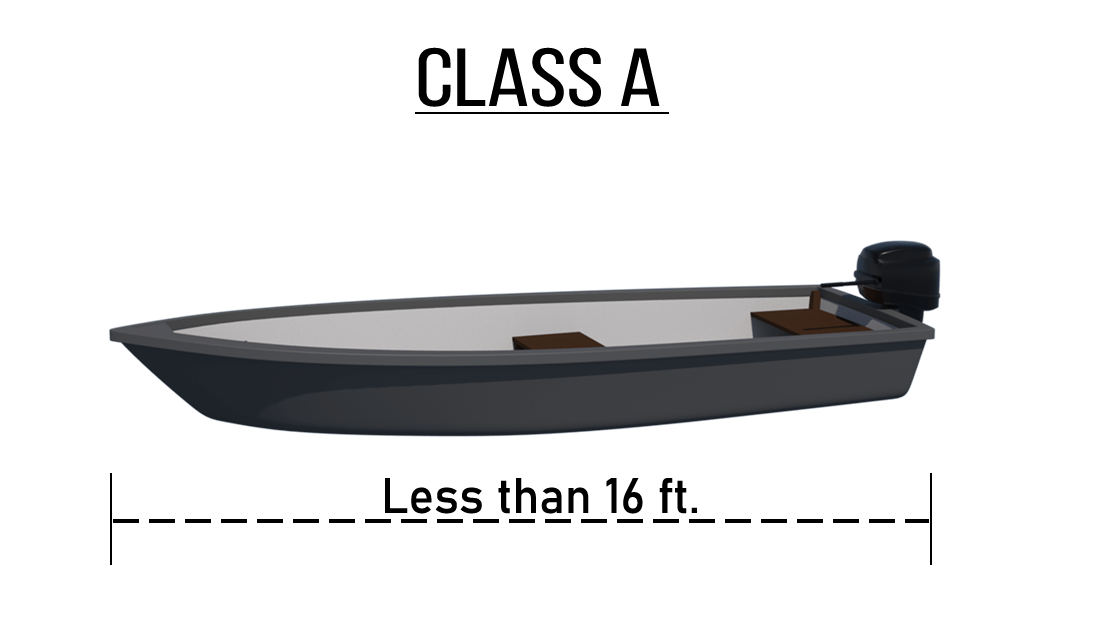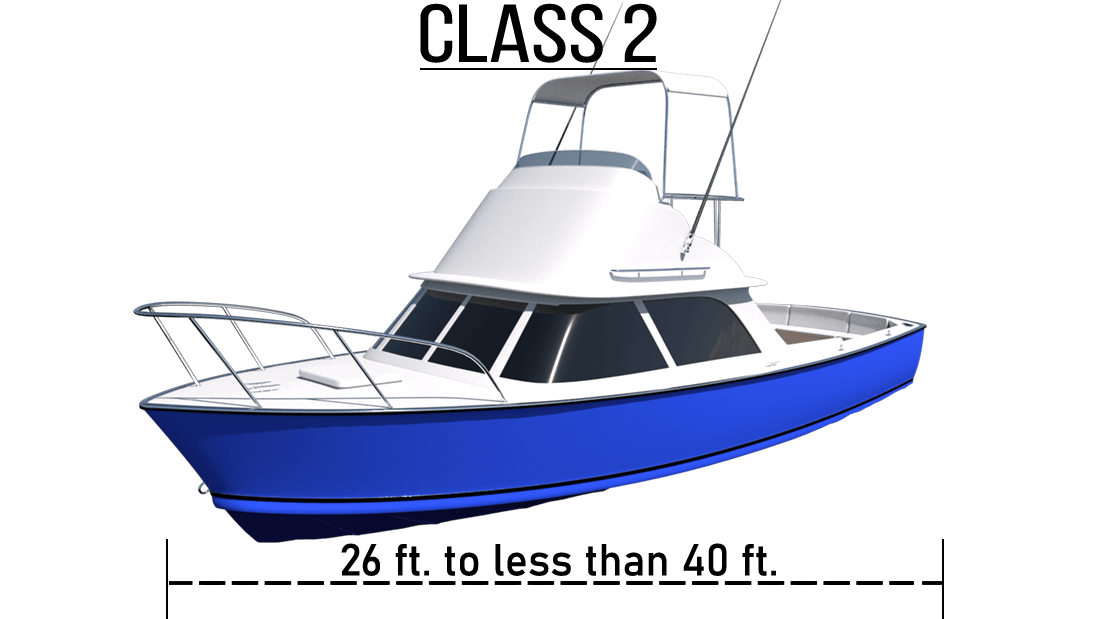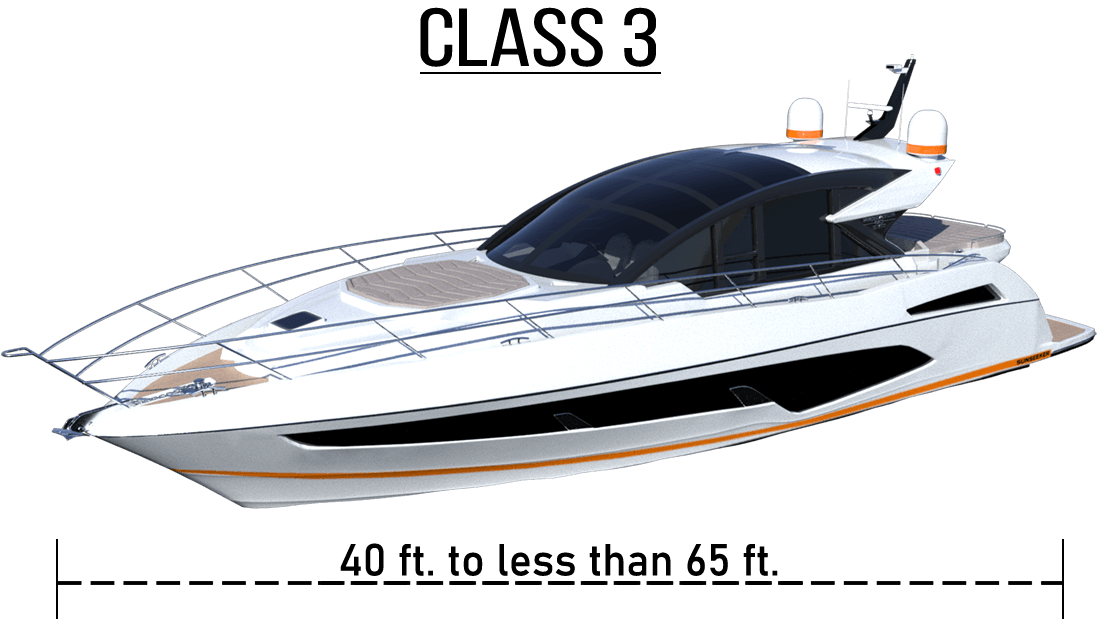Florida Required Boat Safety Equipment

Florida Required Boat Safety Equipment law requires that you have specific safety equipment on board depending on the class of your boat.
Unless otherwise noted, all required equipment must be:
- Coast Guard-approved
- Of the proper type and/or size
- Kept in good, serviceable condition
- Appropriate for the intended activity
- Readily accessible
Motorboats Less than 16'

Life Jackets
One Type I, II, III or V Coast Guard-approved life jacket must be carried for each person on board.
Note: An inflatable life jacket must be worn to be considered readily accessible.
A Type V hybrid may substituted for any Type I, II, or III device, but must be worn whenever the vessel is underway and the person is not in the cabin or other enclosed area.
Every person on board under the age of 6 must wear an approved Type I, II, or III while the vessel is underway.
Personal Watercraft (PWC): Everyone on or operating a PWC must wear an approved Type I, II, III or V PFD. Inflatable PFDs are prohibited.
Water Skier: Every person skiing or aquaplaning must wear an approved Type I, II or III PFD. Inflatable PFDs are prohibited.
Florida Boating License
You need Florida boating license if you were born on or after Jan. 1, 1988, and will be operating a motorized boat of 10 hp or more in Florida.
Fire Extinguisher
Must be USCG-approved - Must be in serviceable condition
One USCG-approved B-1 type fire extinguisher is required for all recreational motorboats except outboard-powered motorboats less than 26 feet long if constructed in a manner that will not allow gas fumes to accumulate. If your boat has a built-in fuel tank, an inboard engine, compartments where portable fuel tanks may be stored, or open areas between the hull and deck where flammable or explosive gases could accumulate, you must carry a fire extinguisher. Non-motorized boats are exempt from the fire extinguisher requirements.
NOTE: When an approved fixed fire extinguishing system is installed in the machinery space(s), it may be counted in the place of one B-I type hand-held portable fire extinguisher. Some fire extinguishers require specific mounting brackets for approval. Read the label on your fire extinguisher for this information.
Backfire Flame Arrestor
An effective means of controlling backfire flame of all gasoline engines installed after April 25, 1940, except outboard motors.
Backfire flame arrestors must be USCG approved.
Ventilation
Boats built prior to Aug. 1, 1980
At least two ventilator ducts fitted with cowls or their equivalent, for the purpose of properly and efficiently ventilating the bilges of every closed engine and fuel-tank compartment on boats constructed or decked over after April 25, 1940, using gasoline as fuel or other fuels having a flash point of 110 degrees or less.
Boats built after Aug. 1, 1980
At least two ventilator ducts for the purpose of efficiently ventilating every closed compartment that contains a gasoline engine and every closed compartment containing a gasoline tank, except for those having permanently installed tanks which vent outside the boat and contain no unprotected electrical devices. Also, engine compartments containing a gasoline engine having a cranking motor must contain power operated exhaust blowers which can be controlled from the instrument panel.
Sound Signaling Devices
A motorboat less than 39.4 feet (12 meters) must be able to provide a means of making an efficient sound signal, but is not required to carry a whistle or bell. Mouth whistle acceptable.
Visual Distress Signals (Coastal Waters Only)
Coastal Waters Only. Boats less than 16 feet are only required between sunset and sunrise to carry aboard devices that are suitable for night use.
NOTE: Coastal waters means the Atlantic Ocean, Gulf of Mexico, and all bays, sounds, harbors, rivers, inlets, etc. where any entrance is over 2 miles wide to the first point where the distance between shorelines narrows to 2 miles.
Navigation Lights
Boats less than 16 feet are only required to carry aboard devices that are suitable for night use between sunset and sunrise.
Capacity Plate
Required
Ventilation
Boats built prior to Aug. 1, 1980
At least two ventilator ducts fitted with cowls or their equivalent, for the purpose of properly and efficiently ventilating the bilges of every closed engine and fuel-tank compartment on boats constructed or decked over after April 25, 1940, using gasoline as fuel or other fuels having a flash point of 110 degrees or less.
Boats built after Aug. 1, 1980
At least two ventilator ducts for the purpose of efficiently ventilating every closed compartment that contains a gasoline engine and every closed compartment containing a gasoline tank, except for those having permanently installed tanks which vent outside the boat and contain no unprotected electrical devices. Also, engine compartments containing a gasoline engine having a cranking motor must contain power operated exhaust blowers which can be controlled from the instrument panel.
Valid Registration
Required if mechanically propelled
Motorboats 16' to Less than 26'(8m)

Life jackets
One Type I, II, III or V Coast Guard-approved wearable life jacket must be carried for each person aboard. Life jackets must be readily accessible and of an appropriate size for the intended wearer.
In addition, the vessel must carry an approved Type IV throw able device, which should be immediately available.
A Type V hybrid may substituted for any Type I, II, or III device, but must be worn whenever the vessel is underway and the person is not in the cabin or other enclosed area.
Every person on board under the age of 6 must wear an approved Type I, II, or III while the vessel is underway.
Water Skier: Every person skiing or aquaplaning must wear an approved Type I, II or III PFD. Inflatable PFDs are prohibited.
Florida Boating License
You need Florida boating license if you were born on or after Jan. 1, 1988, and will be operating a motorized boat of 10 hp or more in Florida.
Fire Extinguisher
One USCG-approved B-1 type fire extinguisher is required for all recreational motorboats except outboard-powered motorboats less than 26 feet long if constructed in a manner that will not allow gas fumes to accumulate. If your boat has a built-in fuel tank, an inboard engine, compartments where portable fuel tanks may be stored, or open areas between the hull and deck where flammable or explosive gases could accumulate, you must carry a fire extinguisher. Non-motorized boats are exempt from the fire extinguisher requirements.
The fire extinguisher must be USCG-approved and must be in serviceable condition.
NOTE: When an approved fixed fire extinguishing system is installed in the machinery space(s), it may be counted in the place of one B-I type hand-held portable fire extinguisher. Some fire extinguishers require specific mounting brackets for approval. Read the label on your fire extinguisher for this information.
Backfire Flame Arrestor
An effective means of controlling backfire flame of all gasoline engines installed after April 25, 1940, except outboard motors.
Backfire flame arrestors must be USCG approved.
Ventilation (Boats built prior to Aug. 1, 1980)
At least two ventilator ducts fitted with cowls or their equivalent for the purpose of properly and efficiently ventilating the bilges of every closed engine and fuel -tank compartment of boats constructed or decked over after April 25, 1940, using gasoline as fuel or other fuels having a flash point of 110 degrees or less.
Ventilation (Boats built after Aug. 1, 1980)
At least two ventilator ducts for the purpose of efficiently ventilating every closed compartment that contains a gasoline engine and every closed compartment containing a gasoline tank, except for those having permanently installed tanks which vent outside the boat and contain no unprotected electrical devices. Also, engine compartments containing a gasoline engine having a cranking motor must contain power operated exhaust blowers which can be controlled from the instrument panel.
Sound Signaling Devices
A motorboat less than 9.4 feet (12 meters) feet must be able to provide a means of making an efficient sound signal, but is not required to carry a whistle or bell. Mouth whistle acceptable.
Visual Distress Signals (Coastal Waters Only)
Coastal Waters Only. All boats 16 feet or more in length must carry devices aboard at all times.
Boaters must carry: EITHER
-
- devices that are suitable for day use and devices suitable for night use, OR
- devices that can be used for both day and night use.
NOTE: Coastal waters means the Atlantic Ocean, Gulf of Mexico, and all bays, sounds, harbors, rivers, inlets, etc. where any entrance is over 2 miles wide to the first point where the distance between shorelines narrows to 2 miles.
Navigation Lights
Navigation lights must be kept in serviceable condition and displayed between sunset and sunrise and at times of restricted visibility.
Capacity Plate
Required
Noise level compliance
90 DBA, measured at idle with all engines operating, measured not less than 4' above water at a point where transom gunwale and port or starboard gunwale intersect.
Valid Registration
Required if mechanically propelled
Motorboats 26' to Less than 40'(8m)

Life jackets
One Type I, II, III or V Coast Guard-approved wearable life jacket must be carried for each person aboard. Life jackets must be readily accessible and properly fit the intended wearer.
A Type V hybrid may substituted for any Type I, II, or III device, but must be worn whenever the vessel is underway and the person is not in the cabin or other enclosed area.
In addition, the vessel must carry an approved Type IV throw able device, which should be immediately available.
Every person on board under the age of 6 must wear an approved Type I, II, or III while the vessel is underway.
Water Skier: Every person skiing or aquaplaning must wear an approved Type I, II or III PFD. Inflatable PFDs are prohibited.
Florida Boating License
You need Florida boating license if you were born on or after Jan. 1, 1988, and will be operating a motorized boat of 10 hp or more in Florida.
Fire Extinguisher
At least two B-I type approved hand-held portable fire extinguisher or at least one B-II type approved hand-held portable fire extinguisher.
The fire extinguisher must be USCG approved and must be in serviceable condition.
NOTE: When an approved fixed fire extinguishing system is installed in the machinery space(s), it may be counted in the place of one B-I type hand-held portable fire extinguisher. Some fire extinguishers require specific mounting brackets for approval. Read the label on your fire extinguisher for this information.
Backfire Flame Arrestor
An effective means of controlling backfire flame of all gasoline engines installed after April 25, 1940, except outboard motors.
Backfire flame arrestors must be USCG approved.
Ventilation (Boats built prior to Aug. 1, 1980)
At least two ventilator ducts fitted with cowls or their equivalent for the purpose of properly and efficiently ventilating the bilges of every closed engine and fuel -tank compartment of boats constructed or decked over after April 25, 1940, using gasoline as fuel or other fuels having a flash point of 110 degrees or less.
Ventilation (Boats built after Aug. 1, 1980)
At least two ventilator ducts for the purpose of efficiently ventilating every closed compartment that contains a gasoline engine and every closed compartment containing a gasoline tank, except for those having permanently installed tanks which vent outside the boat and contain no unprotected electrical devices. Also, engine compartments containing a gasoline engine having a cranking motor must contain power operated exhaust blowers which can be controlled from the instrument panel.
Sound Signaling Devices
A motorboat less than 9.4 feet (12 meters) must be able to provide a means of making an efficient sound signal, but is not required to carry a whistle or bell. Mouth whistle acceptable.
Vessels 9.4 feet (12 meters) or more in length are required to carry a whistle and a bell.
Visual Distress Signals (Coastal Waters Only)
Coastal Waters Only. All boats 16 feet or more in length must carry devices aboard at all times.
Boaters must carry: EITHER
-
-
- devices that are suitable for day use and devices suitable for night use, OR
- devices that can be used for both day and night use.
-
NOTE: Coastal waters means the Atlantic Ocean, Gulf of Mexico, and all bays, sounds, harbors, rivers, inlets, etc. where any entrance is over 2 miles wide to the first point where the distance between shorelines narrows to 2 miles.
Navigation Lights
Navigation lights must be kept in serviceable condition and displayed between sunset and sunrise and at times of restricted visibility.
Noise level compliance
90 DBA, measured at idle with all engines operating, measured not less than 4' above water at a point where transom gunwale and port or starboard gunwale intersect.
Valid Registration
Required if mechanically propelled
Motorboats 40' to Less than 65'(8m)

Life jackets
One Type I, II, III or V Coast Guard-approved wearable life jacket must be carried for each person aboard. Life jackets must be readily accessible and properly fit the intended wearer.
A Type V hybrid may substituted for any Type I, II, or III device, but must be worn whenever the vessel is underway and the person is not in the cabin or other enclosed area.
In addition, the vessel must carry an approved Type IV throw able device, which should be immediately available.
Every person on board under the age of 6 must wear an approved Type I, II, or III while the vessel is underway.
Water Skier: Every person skiing or aquaplaning must wear an approved Type I, II, or III PFD. Inflatable PFDs are prohibited.
Florida Boating License
You need Florida boating license if you were born on or after Jan. 1, 1988, and will be operating a motorized boat of 10 hp or more in Florida.
Fire Extinguisher
At least three B-I type approved hand-held portable fire extinguisher at least one B-I plus one B-II type approved hand-held portable fire extinguisher.
The fire extinguisher must be USCG-approved and must be in serviceable condition.
NOTE: When an approved fixed fire extinguishing system is installed in the machinery space(s), it may be counted in the place of one B-I type hand-held portable fire extinguisher. Some fire extinguishers require specific mounting brackets for approval. Read the label on your fire extinguisher for this information.
Backfire Flame Arrestor
An effective means of controlling backfire flame of all gasoline engines installed after April 25, 1940, except outboard motors.
Backfire flame arrestors must be USCG approved.
Ventilation (Boats built prior to Aug. 1, 1980)
At least two ventilator ducts fitted with cowls or their equivalent for the purpose of properly and efficiently ventilating the bilges of every closed engine and fuel -tank compartment of boats constructed or decked over after April 25, 1940, using gasoline as fuel or other fuels having a flash point of 110 degrees or less.
Ventilation (Boats built after Aug. 1, 1980)
At least two ventilator ducts for the purpose of efficiently ventilating every closed compartment that contains a gasoline engine and every closed compartment containing a gasoline tank, except for those having permanently installed tanks which vent outside the boat and contain no unprotected electrical devices. Also, engine compartments containing a gasoline engine having a cranking motor must contain power operated exhaust blowers which can be controlled from the instrument panel.
Sound Signaling Devices
Vessels 39 feet 4 inches (12 meters) or more in length are required to carry a whistle and a bell.
Visual Distress Signals (Coastal Waters Only)
Coastal Waters Only. All boats 16 feet or more in length must carry devices aboard at all times.
Boaters must carry: EITHER
-
- devices that are suitable for day use and devices suitable for night use, OR
- devices that can be used for both day and night use.
NOTE: Coastal waters means the Atlantic Ocean, Gulf of Mexico, and all bays, sounds, harbors, rivers, inlets, etc. where any entrance is over 2 miles wide to the first point where the distance between shorelines narrows to 2 miles.
Navigation Lights
Navigation lights must be kept in serviceable condition and displayed between sunset and sunrise and at times of restricted visibility.
Noise level compliance
90 DBA, measured at idle with all engines operating, measured not less than 4' above water at a point where transom gunwale and port or starboard gunwale intersect.
Valid Registration
Required if mechanically propelled